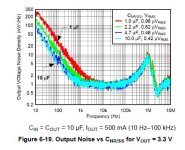But 1/f noise is a bit higher than in LT3042/45.even better noise (~1nV/rtHz)
If we compare the curves with 4.7uF reference bypass for both, the 1/f noise is almost the same (80..100nV/rtHz @ 10Hz). Set current is 150uA, so 150% of 3045 set current which may help a bit (lower set resistor). For the same RC time constant we would actually need to compare to a 3.3uF bypass on the 3045 which would result in slightly higher 1/f.But 1/f noise is a bit higher than in LT3042/45.
Max allowed bypass for 3045 is 22uF, for 7A94/96 it is 100uF and that would indicate achievable 1/f noise could be quite a bit lower for 7A94/96.
I have to disagree with that as noise graphs in TPS7A94 datasheet do not support that. There is no improvement of 1/f noise from 4.7uF to 10 uF. Also the noise peak around 1MHz is troubling. And for LT3042/3045 22uF is not max allowed bypass but it is rather the highest recommended.
Attachments
Well, at some point there could be back-power issues when the bypass were, say 1000uF.I have to disagree with that as noise graphs in TPS7A94 datasheet do not support that. There is no improvement of 1/f noise from 4.7uF to 10 uF. Also the noise peak around 1MHz is troubling. And for LT3042/3045 22uF is not max allowed bypass but it is rather the highest recommended.
There must be a reason for the 22uF recommendation (other than startup time). Maybe it is as simple as "no further improvement beyond that point" which I have to admit is what we might be seing on the 7A94. 7A96 spec sheet -- the one I looked at -- doesn't have a plot for Cnr/ss, so I missed the 7A94 plot.
But there is another one for higher current where 10uF does improve things over 4.7uF:
I do agree to the peaking issue, that doesn't look very nice.
Another member has succesfully tried 100uF bypass with LT3042/45:
https://www.diyaudio.com/community/threads/low-noise-regulator-for-dac-clock.304013/post-7022268
https://www.diyaudio.com/community/threads/low-noise-regulator-for-dac-clock.304013/post-7022268
